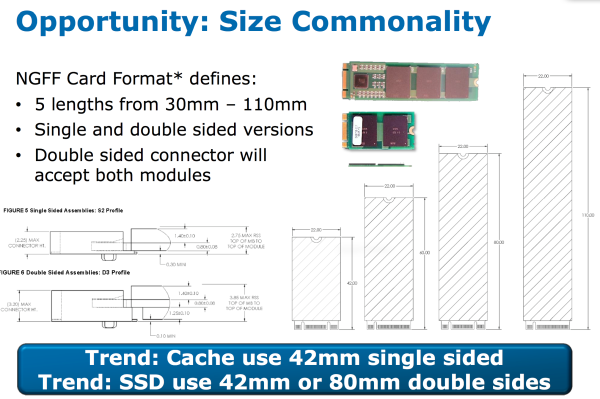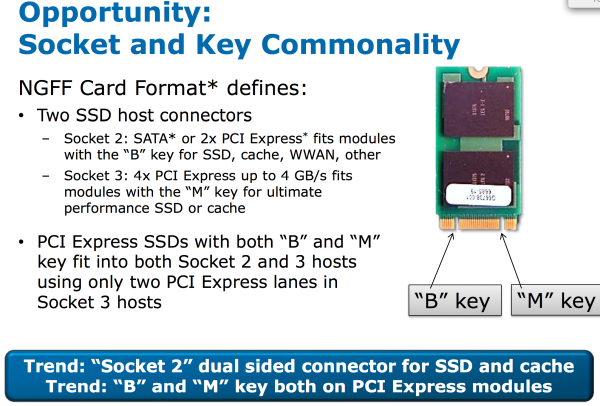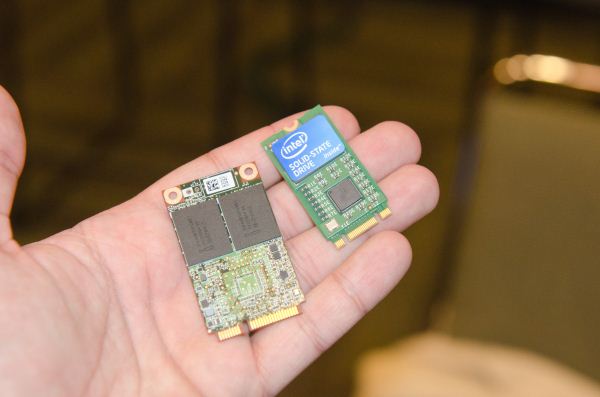NGFF SSDs: Putting an End to Proprietary Ultrabook SSD Form Factors
by Anand Lal Shimpi on September 13, 2012 2:32 PM ESTWe've seen a bunch of custom SSD form factors with the arrival of Ultrabooks as well as systems like the MacBook Air and Retina MacBook Pro. The need is simple: standard 7mm or 9.5mm SSDs are too big for some of these machines, and you don't actually need all of that volume to build a fast drive. mSATA cards work as a small form factor solution but they are only available in a single size. We need flexibility both on length (to allow for higher capacities) as well as on the interface side to enable higher performance. The NGFF specification gives us just that.
The spec allows for SATA, PCIe x2 or PCIe x4 interfaces. It also includes definitions for five different card lengths.
The proposed spec includes two connector definitions: Socket 2 and Socket 3. Socket 2 allows for SATA or PCIe x2 interface for SSDs, WWAN or other non-storage devices. Socket 3 is strictly for high-performance storage, offering up to 4GB/s of bandwidth in a tiny little package.
This is super exciting as far as I'm concerned. We've strayed too far from standardization and upgradability in the pursuit of ultimate mobility. Now all we need is a smaller form factor user replaceable memory standard.
Update: I just got some hands on shots with a few NGFF samples:
mSATA on the left, NGFF on the right



















41 Comments
View All Comments
SteveTheWalrus - Thursday, September 13, 2012 - link
Apple usually likes its own standards vs. ones the industry likes, but it would nice if they did. I also hopes aus puts these in the next zenbook ( or really that all ultrabook class devices adopt these)vlado08 - Thursday, September 13, 2012 - link
Small NGFFcards used like SD cards !CaptainDoug - Friday, September 14, 2012 - link
Wow. That seems super possible.nerd1 - Thursday, September 13, 2012 - link
Basically all ultrabook / tablet OEMs are using them except for apple, and 256GB mSATA drives are already common (512GB ones are on sale too)And mSATA drives are half the size of what Apple uses too.
madmilk - Thursday, September 13, 2012 - link
Half the size is hardly a good thing if you need more capacity though. For example, Apple offers 768GB drives in their laptops (for an exorbitant price), which is a pretty good jump over a 512GB mSATA drive. (Admittedly, I cannot find it on sale anywhere, though apparently Crucial makes them.) This NGFF card format does a pretty good job solving that with different lengths.nerd1 - Thursday, September 13, 2012 - link
Because of mSATA cards being half the size, Apple could put TWO mSATA slots instead of having one proprietary slot, letting customer upgrade using one free slot or go for RAID 0 for even better performance.Guspaz - Thursday, September 13, 2012 - link
Except mSATA is not half the size. while the Apple style is roughly 24mm x 109mm x 3.9mm, while the mSATA drives are 51mm x 30mm x 4.9mm.It's half the length, yes, but it's 25% wider and thicker. That'd make it harder to fit in a lot of places where thickness or width is important.
nerd1 - Friday, September 14, 2012 - link
http://cdn.arstechnica.net//wp-content/uploads/201...MBA one is indeed narrower, but rMBP one is WIDER than mSATA.
darwiniandude - Saturday, September 15, 2012 - link
That's what she said.Alexvrb - Thursday, September 13, 2012 - link
The B and M keys of the new standard also irritates me a bit. If you're going to make a new standard to replace mSATA, and it's got PCIe in both sockets 2 and 3 (2X vs 4X), why not just make them all socket 3 PCIe 4X and standardize on that? If you want SATA there's still mSATA.